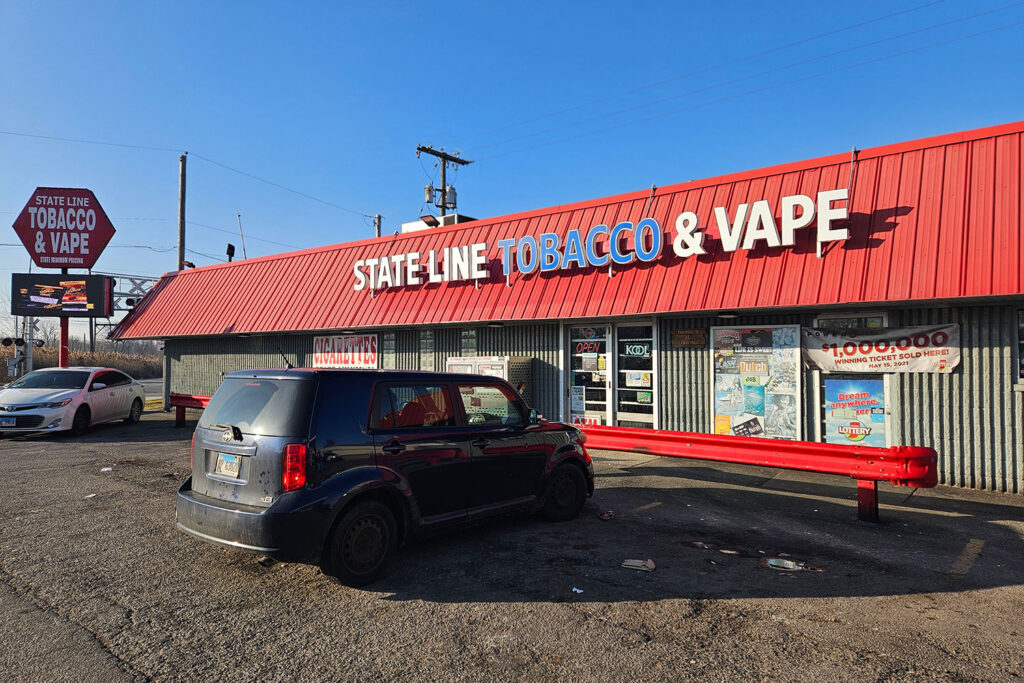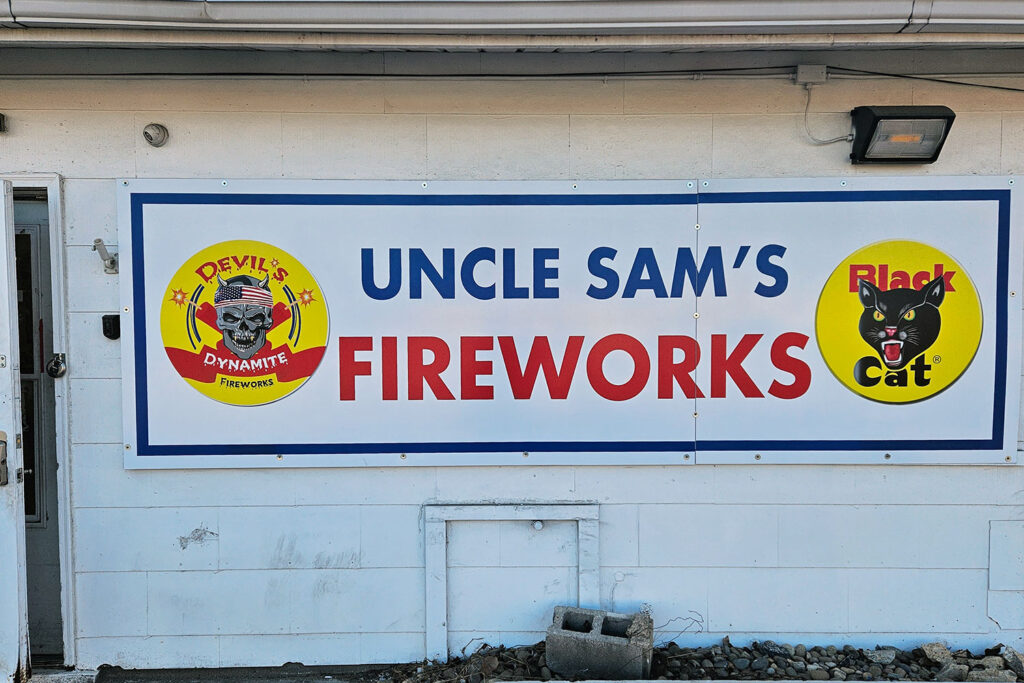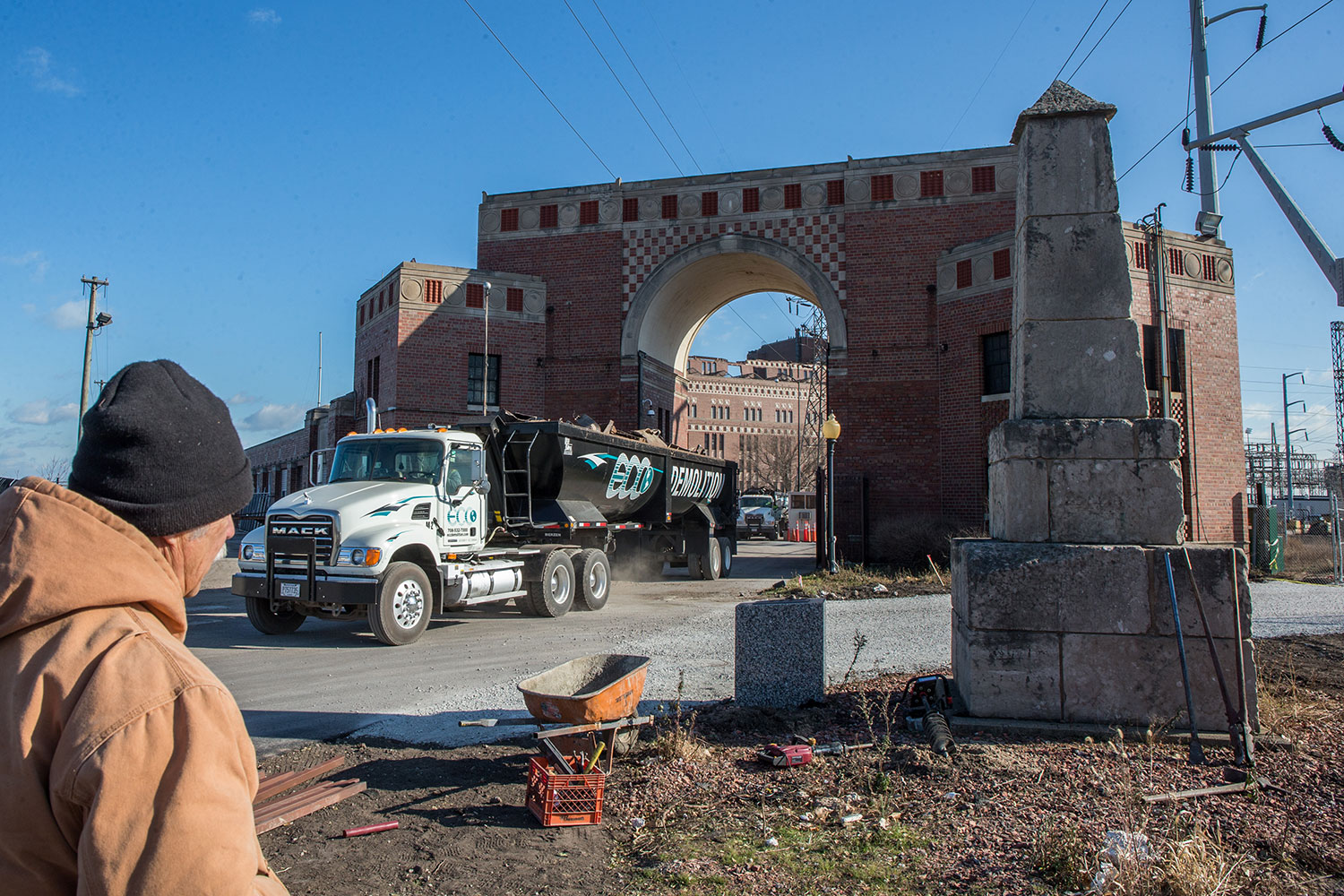It may be the oldest standing structure in Chicago: a cracked, pockmarked limestone obelisk, about four feet high, standing atop an equally cracked, pockmarked pediment at the south end of Calumet Park. Erected in 1838, it marks the border between two neighbors who don’t have much in common, and haven’t always been neighborly: Illinois and Indiana. Right behind it is a triumphal stone arch marking the entrance to a Northern Indiana Public Service Company power station. It’s the gateway to Indiana. Hoosiers are not renowned for their monuments — they’d rather show off a covered bridge — but this arch looks like a monument to the rivalry between two states, an attempt to awe Chicagoans who step across the border.
The straight line that demarcates Indiana and Illinois runs 159.359, from Lake Michigan to the Wabash River, which forms the border the rest of the way. I set out to follow the first few miles, specifically, Chicago’s border with Indiana. It’s not easy to follow. In fact, in most places, it’s impossible. Directly south of the marker, it runs through a field of reeds, then across the South Shore Line tracks, which lie between fences topped with barbed wire. I rented a Divvy in Cal Park, and pedaled it to 106th Street, which meets State Line Road just past the Crow Bar, the ironworkers tavern that once sued the disco Crobar for stealing its name. Staring at me was a sign reading “More Discover. Indiana (™). Est. 1816.” Two years before Illinois, if you’re counting.
In three-quarters of a mile, State Line Road captures the essence of the states it separates: on the Illinois side are block after block of Chicago bungalows. On the Indiana side, in Hammond, are electrical towers that look like chromed kachina dolls, the marquee of the Horseshoe casino, a steaming factory, a Walmart, and Interstate 90, which has just flattened out after its decline from the Skyway.
There are, perhaps, bordering states that are more dissimilar than Illinois and Indiana. Illinois also borders Kentucky, after all. But it’s hard to find a border where the differences between two states are so distinct. Northwest Indiana, also known as the Region, short for the Calumet Region, is Chicago’s Tijuana, an unregulated land of cheap cigarettes, fireworks, 200-proof alcohol, titty bars (Industrial Strip), and steel mills that have remained in business because Indiana allows them to pollute as much as they please. It’s a reflection of each state’s political outlook, and its cultural center of gravity.

“In Indiana, we don’t go looking for problems to solve,” an observer of Hoosier politics once told me. “We live and let live.”
Dominated by the heartland city of Indianapolis, Indiana has an Individualistic political culture, in which “Government’s role is limited, primarily to keep the marketplace functioning.” Chicago was settled by New England Yankees, who brought with them a Moralistic culture, in which “Government advances the public interest and is a positive force in the lives of citizens.” In the name of “liberty,” Indiana tolerates vices – drinkin’, smokin’, shootin’ and gamblin’ — but cracks down on what it sees as sins. Last year, the Indiana legislature passed a law banning abortion except if a woman’s life or health is in danger. Just as Illinoisans sneak across the state line for cheap gas (Indiana’s gas tax is five cents a gallon lower than Illinois’s), Hoosiers are sneaking over here to get an abortion, which is a “fundamental right” in Illinois. Indiana is a red state, which has voted Republican in all but one presidential election since 1964 (it made an exception for Barack Obama). Illinois is a blue state, which has voted Democratic in every presidential election since 2008.
Anyway, back to the state line. After six blocks, State Line Road ends at Eggers Grove, where following the line on a Divvy is nearly impossible, since it requires pedaling down soft dirt trails. In Wolf Lake (where Leopold and Loeb dumped their victim’s body), there is a man-made peninsula running along the state line, with plenty of parking spots for fishermen. I pedaled around the lake, past Harbor Point Estates, Chicago’s only trailer park, and then down Brainerd Avenue.
There is no need for a “More to Discover. Indiana” sign where Brainerd Avenue crosses into the state. You know you’re in Indiana when you see a Mobil gas station selling gas for $2.59 a gallon. Then the State Line Tobacco & Vape smoke shop. (Indiana’s cigarette tax is 99 cents a pack. Let the marketplace rule. Illinois’s is $2.98. Smoking is bad for the lungs.) And Uncle Sam’s Fireworks Store. The 11-year-old in me gravitated to the fireworks stand. Indiana doesn’t care whether shit gets blown up. Let the marketplace decide whether and what shit gets blown. Inside were shelves and shelves of Pop Stars, Wake the Neighbors, Angry Pandas, Sensory Overload.

“Novelties, sparklers, fountains, and smoke are legal in Illinois,” said the owner, Dan, who posts his name and number on the door so customers can call or text him if he’s not there and they really, really need fireworks. He lives five minutes away. “Ninety-nine percent of our customers are from Illinois. Lunar New Year’s coming up. People are buying ’em.”
At the counter, two Chinese men were filling a cardboard box with explosives. I bought a package of Devil’s Dynamite, which Dan said are “louder than regular firecrackers.” A few days later, I set them off on a beach in Chicago, planting their butts in the sand. They burst so loudly that two women walking a dog looked over, startled at the illegal explosion. Illinois is one of only four states that bans fireworks, so I was violating the Illinois Pyrotechnic Use Act. The sale, possession and use of fireworks is a Class A misdemeanor in Illinois, punishable by a fine of up to $2,500 and a year in jail.
Indiana is often written off as a state that’s good for nothing but taking up space between Chicago and Cincinnati. But it turns out that Indiana is a good neighbor. Indiana and Illinois complement each other well. We’ve got skyscrapers, blues clubs, Broadway theater, three-star restaurants, and abortions. They’ve got steel mills, sand dunes, gun shops offering easy access to firearms…and fireworks. Damn that Devil’s Dynamite is loud.



